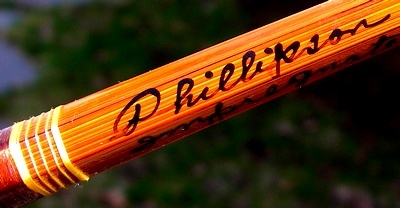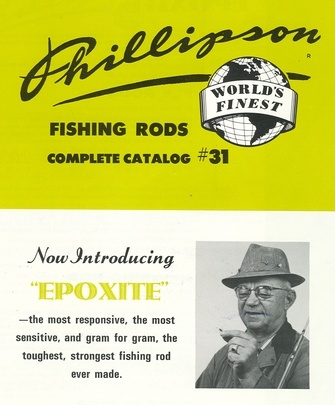(Click to read
"Bury Me With My Phillipson Bamboo Fly Rods," Part I)
Some fly rods exert a powerful hold on those who use them, and when a rod marries itself to your casting stroke, only a fool would put it down in the pursuit of new technology or glossier finish.
In truth, fly fishers chose their fly rods for many different reasons, and when you stumble across a series of rods that fish well and come neatly packaged with an interesting background, well... let's just say I'm a sucker for that kind of thing.
Bamboo RodsMy first bamboo fly rod (going on 15 years from now) was a revelation, but my first Phillipson was a godsend.
In truth, my first cane rod was smooth, but it wasn't much in the way of an all-around rod.
A unmarked 8' 5wt of indeterminate manufacture, it was fun to fish but lacked the backbone to set the hook on all but the slowest-reacting trout. God forbid I should try to fish a streamer.
The first Phillipson I cast immediately soured me on the previous rod. Almost as smooth and far more powerful, here was a bamboo rod that felt like a fly rod was supposed to feel, yet it fished – to my purposes – as well as any of the graphite rods I owned.
 One of my 8' 5wt Phillipsons -- this one an impregnated model.
One of my 8' 5wt Phillipsons -- this one an impregnated model.Long casts? It did the job on the rivers I fished, especially once I let the rod do the work. And short casts? Nothing clothed in carbon came close.
It was an 8' 5wt, I fished it a lot, and when I had the chance to buy an 8.5' 5wt Phillipson, I latched onto it immediately.
Here was a rod with the delicacy to fish #18 BWO dries and high stick dries in pocket water, yet it could cast to any reasonable fishing distance provided the caster wasn't an impatient brute, lacking in refinement and personal hygiene.
With those two Phillipsons firmly in hand, I started digging into the company's past, and what I unearthed pretty much sealed the deal.
The Phillipson StoryBill Phillipson was a Swedish immigrant who started working for the Denver-based Granger rod company in the 1920s.
By all accounts a natural craftsman, he was also an independent thinker with a knack for solving problems.
When Goodwin Granger died in the early 1930s, Phillipson quickly ascended to Operations Manager. It was then he began the series of battles with the company's office manager that helped define his legend in the rod building industry.
"Victory"Early in his tenure at Granger, Phillipson butted heads with the office manager, a woman whose name I have written down but can't recall. Both wanted control over the rod operation.
Eventually, the infighting grew so fierce that Goodwin Granger's window had to step in and settle it. She awarded Phillipson control, and rumor has it he issued the "Victory" model Granger fly rod in celebration.
Michael Sinclair – a bamboo rod historian and fan of Bill Phillipson – said no one could positively confirm the story, but that those close to Phillipson thought it had the ring of truth.
"51"The Granger operation was shut down for WWII. After the war ended, the widow Granger wanted to sell the company rather than reopen it.
Both Bill Phillipson and the Wright-McGill company were in competition to buy the company, with Bill Phillipson offering less cash but a richer percentage of future sales.
The office manager was reported to have said that if Phillipson got the company, it wouldn't exist five years hence.
Eventually, the company went to Wright-McGill (I've also heard this statement attributed to the Widow Granger, but Sinclair said manager, and I trust him), and Phillipson started The Phillipson Rod Company, which quickly grew into a success.
Never forgetting the slight, Phillipson later marked all his 1951 rods with a "51" to commemorate his company's fifth year in operation. Zing!
Frankly, you can't buy style like that. You're born with it.
And if you happen to have a Phillipson with the "51" on it (as I do – a 9' Pacemaker), you can't help but look at it and chuckle.
Sell it? Don't even ask.
A Populist Rod?Phillipson's rods are often maligned for their nylon thread wraps, purple glue lines and ingenious plastic or metal reel seats, but it's important to note that Phillipson never wanted to build works of art.
He built fishing rods, and while their less-refined appearance has kept Phillipson prices within reason (the collectors of the short, ultra-refined eastern-style rods simply paid Phillipsons no mind), they have been "discovered" as of late.
Used Phillipson rods don't yet approach the prices of the Grangers -- most of which were also built under Bill Phillipson's direction -- but prices have been rising.
This is in contrast with Phillipson's ability to keep his rods priced low, a result of refined manufacturing techniques. The best value in the line was probably the Pacemaker, which carried a $25 price tag during the late 40s and early 50s, though even his highest-quality rod (the tapers were identical, only the quality of the cane and fittings changed) only cost $75.
I've seen estimates suggesting Phillipson's bamboo rod production never rose above 8,000-10,000 rods per year until he started selling some of the premier fiberglass rods of the era, when production rose to the 25,000-30,000 range.
 One of the later Phillipson catalog covers, and a picture of Bill himself.
One of the later Phillipson catalog covers, and a picture of Bill himself.While some found the wraps on his bamboo rods a bit on the gaudy side, I like them.
Others have downplayed the cosmetics of his bakelite and "no rock" metal reel seats -- which don't suggest the "polished by virgins until glossy" refinement of far more expensive rods -- but unlike some of those rods, I've never had a reel abruptly vacate a Phillipson reel seat.
And his purple glue lines? They exist because the purple glue was simply the best available at the time. Strong and waterproof, the glue allowed Phillipson to impregnate some of his rods with a resin after they'd been glued up (instead of before).
This developed a waterproof seal on the rod, but kept the resin from soaking into the pithy center portion of the rod. As a result, Phillipson's impregnated rods gained less weight than the Orvis models and fished better as a result.
Phillipson's Legacy: His RodsIt's important to note that Phillipson wasn't simply a machinist with a penchant for making fly rods; he was an expert caster and fisherman.
He set a world fly casting distance record (140 feet, 1934, Altamont CO), and was often seen prowling the banks of the South Platte river until a few years before Alzheimers claimed him in 1987 at the age of 83.
Befitting a Western fly fisher, Phillipson's best rods were probably his 8', 8.5' and 9' models, but in Part III, I'll write more about the rods Bill Phillipson left behind, including his fiberglass models.
Until then, see you at the "5" rod rack, Tom Chandler.
 A 1949 magazine ad.
A 1949 magazine ad.(Click to read
"Bury Me With My Phillipson Bamboo Fly Rods," Part III)
(Click to read
"Bury Me With My Phillipson Bamboo Fly Rods," Part I)
bamboo, bamboo fly rods, fiberglass fly rods, phillipson, phillipson bamboo fly rods, phillipson fly rods, fly fishing, fly rod